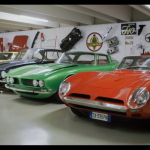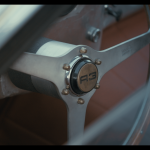
The Iso Rivolta Chronicles: Episode I
January 1975. Bresso, a few kilometers north of Piazza del Duomo in Milan. The day before, end of 1974, Iso Rivolta’s firm gates had closed forever. They will never open again, delivering to history the events of an ambitious and unfortunate car brand, that wrote a page in the story of Italian industry and was forgotten, as time went by.
The story of the firm, found by Mr. Renzo Rivolta, who had started producing motor vehicles in 1948, has come to light today in an episode documentary, The Iso Rivolta Chronicles, produced by An Italian Garage project. Eight videos about each and every model produced by the Lombard brand, narrated through the stories of the brand’s lovers, who are passionately keeping its memory alive.
When you think about Iso Rivolta, its most remarkable model, the Iso Grifo, comes first to your mind. Produced from 1965 to 1974 it was the perfect blend of what one could desire in a luxury, highly performing car. The body is a masterpiece made for Bertone by Giorgetto Giugiaro and is an example of Italian artistic geniality in those decades. But the surprise lies under the hood. It just takes to start the engine to taste a bit of America. The sound of its V8 cylinder engine recalls a 5.3 liters Chevrolet Small Block.
It can be clearly heard in the first episode of the series, about Hungarian communication agent and car lover Adam Bolcs. Adam passion for the Italian brand had started with the Iso Grifo Matchbox model car in his childhood and has happily ended with him driving his own Iso Grifo.
Two of them are owned by Federico Bonomelli, one being the rare 7Litri, mounting a L71 Big Block able to produce up to 435hp. To install and manage this propeller in a Grifo, the chassis was reinforced and the hood was modified with a huge rectangular extrusion, which makes it immediately recognizable. This model also symbolizes the end of the working relationship between Renzo Rivolta and Giotto Bizzarrini, who had developed the idea. Born as the A3/C project and meant for races, the Grifo was instead produced in its A3/L Stradale version. Named simply Grifo, it was the main concern of all production efforts made by Iso. That was the beginning of disagreements with Bizzarrini, who left the firm in Bresso to develop and produce the A3/C under his name, later known as the Bizzarrini 5300GT Strada. Giotto Bizzarrini himself had declared that the Iso Grifo was his second aerodynamic study after the Ferrari 250GTO and was even better than the Cavallino Rampante‘s, with just a reduction of some small flaws in the rear.
The Iso Rivolta, moreover, focused on independent front suspensions, the De Dion tube in the rear, together with an engine and a gearbox definitely backward-placed, for a better weight distribution. Though the Grifo is the Iso’s best known and celebrated model, the most unappreciated is the GT300. Almost forgotten by the public, it is still outstanding for its innovative lines and peculiar style, those too born from Giugiaro’s creative mind. Launched in 1962, it was to be the car of Iso Rivolta’s boom, on the American market in particular; but, partly because of high prices and a limited overseas fame, partly because of a quality rate not up to Rivolta standards, it was not as successful as expected. The result, in figures, was acceptable, with 798 pieces, plus two prototypes between 1962 and 1970.
The GT300, later renamed IR300, was also produced and sold as a GT340. Its numbers recall the Chevrolet 5.3lt, which could reach a maximum speed of 218 or 228kph, with an acceleration ratio from 0 to 100km in 7.9 or 8.4 seconds. Very high performing standards for the time, bearing in mind that the car was meant for wealthy people. It had to combine the performance of a sports car with the elegant lines and the comfortable inside of a luxury car; those were to be its fundamentals, according to Renzo Rivolta, who wanted a fast but everyday car, with a price standing in between a Jaguar’s and a Ferrari’s.
Among contemporary entrepreneurs, Federico Bonomelli himself owns an Iso Rivolta GT300. In an interview by An Italian Garage, he had described it as a car to be very carefully driven, due to different compulsory security levels in the 60s, to its powerful performances on the road and a braking system too dangerous for non-expert drivers. You need the same experience to drive the three models produced by the brand in Bresso.
Each of them had left their mark in the world of four wheels and it today enjoying a new life, thanks to a group of fans, passionate lovers of historical cars and Italian style.
To see the documentary, CLICK HERE
Article – Daniele Boltin, English version – Nilla Pestrin
Photo credits: Alessandro Venier and An Italian Garage





















